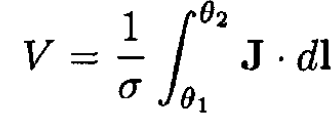


 الفيزياء الكلاسيكية
الفيزياء الكلاسيكية
 الكهربائية والمغناطيسية
الكهربائية والمغناطيسية
 علم البصريات
علم البصريات
 الفيزياء الحديثة
الفيزياء الحديثة
 النظرية النسبية
النظرية النسبية
 الفيزياء النووية
الفيزياء النووية
 فيزياء الحالة الصلبة
فيزياء الحالة الصلبة
 الليزر
الليزر
 علم الفلك
علم الفلك
 المجموعة الشمسية
المجموعة الشمسية
 الطاقة البديلة
الطاقة البديلة
 الفيزياء والعلوم الأخرى
الفيزياء والعلوم الأخرى
 مواضيع عامة في الفيزياء
مواضيع عامة في الفيزياء|
Read More
Date: 18-8-2016
Date: 29-8-2016
Date: 19-8-2016
|
Spherical Resistor
A and B are opposite ends of a diameter AOB of a very thin spherical shell of radius a and thickness t. Current enters and leaves by two small

Figure 1.1
circular electrodes of radius b whose centers are at A and B (see Figure 1.1). If I is the total current and P is a point on the shell such that the angle POA = θ, show that the magnitude of the current density vector at P is proportional to (2πat sinθ)-1. Hence find the resistance of the conductor.
You may find this integral useful:

SOLUTION
The current density at point P may be written down immediately because of the cylindrical symmetry of the problem (see Figure 1.2). The current

Figure 1.2
is divided evenly through 2π so that the current density J at each point in the spherical shell is
 (1)
(1)
From the equation J = σE, where σ is the conductivity of the shell, we obtain

where V is the potential difference between the two electrodes. So
 (2)
(2)
From the hint in the problem (which can by computed by using the substitution tan θ/2 = t) we can take the integral in (2):

As the radius b of the electrodes goes to zero, the resistance goes to infinity!



|
|
|
|
علامات بسيطة في جسدك قد تنذر بمرض "قاتل"
|
|
|
|
|
|
|
أول صور ثلاثية الأبعاد للغدة الزعترية البشرية
|
|
|
|
|
|
|
مستشفى العتبة العباسية الميداني في سوريا يقدّم خدماته لنحو 1500 نازح لبناني يوميًا
|
|
|